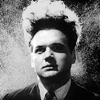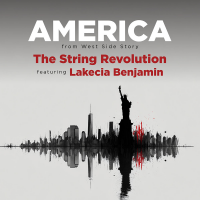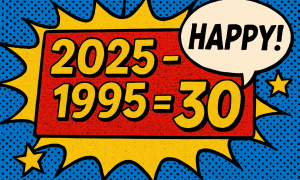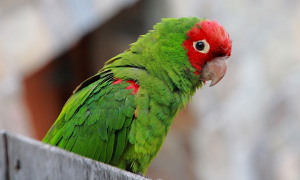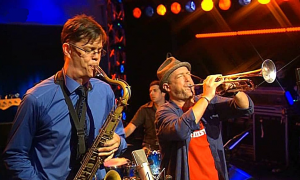Home » Jazz Articles » Genius Guide to Jazz » Prelude
Prelude
Musicians in the fifties were the very epitome of everything cool. Just the presence of Miles Davis and John Coltrane lowered the earth's average temperature by 2.4 degrees...
Anyway.
I love jazz. I love everything about jazz. I love listening to jazz. I love reading about jazz, hearing people talk about jazz, pictures of jazz musicians. I love pictures of people listening to people talk about jazz. I love reading about hearing people listening to jazz. I love talking about reading about listening to people take pictures of'wait, I've completely lost track of this article already. Or, better yet, maybe I was riffing. This being an article about jazz, I could very well claim that I was wasn't just prattling on, I was actually building on an established motive to create an atmospheric sense of space within the confines of the traditional boundaries of the written word. Or maybe I'm just full of crap. The very same debate has been raging around Cecil Taylor for years, so I'm in good company.
At any rate.
We've established two things already. First is the fact that I like jazz, and second is the fact that I'm either pretty damned clever or completely full of a substance known in the jazz vernacular as "Kenny G CD's." Either way, we're too far into it to turn back now so we might as well just hang on and enjoy the rest of the piece.
That said.
Any discussion of jazz must first begin with the fundamental question, "What is jazz?" One might define jazz as a form of musical self-expression that transcends the established limits of the European classical tradition and emphasizes both an exceptional level of technical ability and an intimate personal revelation of the individual musicians within a variety of ensemble settings, but that sort of talk isn't likely to get you invited to too many parties. It is easier to define jazz in a similar fashion to the way pornography was defined by Chief Justice Oliver Wendell Holmes (32-1-1, 26 KO's), you know it when you see it. Or rather, when you hear it. Jazz, that is, not pornography (although, jazz is sometimes used as background music for porno flicks. I have no personal knowledge of this).
Having thus wriggled off the hook, we can now move past the question of what is jazz and get on to the larger issues of just how the hell I managed to get my own spot on this website. Or, we could explore the vast, rich legacy of jazz and maybe find a few ways to help make our music relevant to a new generation. Either way, I'm easy.
So then.
Let's begin with a brief, yet largely incorrect, history of the music we all love so much.
I. Prelude
The history of jazz begins in New Orleans, where an influx of disparate but oddly complementary cultures combine not only to create the framework on which jazz would be built, but also an atmosphere where one day, drunken college coeds would bare their breasts in exchange for plastic beads. It is for these contributions to society that New Orleans can be forgiven for the NFL's Saints (but not, however, for that whole "Cajun-blackened everything" craze that still lingers in many full-service restaurants to this day). It is still a matter of debate as to whether jazz began as a natural progression from blues and field chants, or whether it was simply a way to discourage people from playing the banjo. Early pioneers of the form include the great coronetist Buddy Bolden, and impresario and composer "Jelly Roll" Morton who claimed not only to have single-handedly invented jazz, but also took credit for discovering elements 92-104 on the periodic table. Experts today doubt the veracity of these claims, but are at a loss to explain the element jellyrollium.
As jazz spread from New Orleans, gradually reaching the metropolitan centers of the industrial North as well as the most remote areas of the South and Midwest, it attracted both musicians and listeners to its unique and exciting sound. It also produced its first legitimate giant, the great Louis "Satchmo" Armstrong. A natural musician with a virtuoso talent for improvisation and a sound as big as Ted Kennedy and Oprah Winfrey at an all-you-can-eat buffet (an early contender for cheapest gag of the piece), Armstrong quickly became a marquis name with his work with the King Oliver band in Chicago. It wasn't long before Armstrong struck out on his own, beginning a solo career that would span almost six decades and leave an immense legacy as one of the greatest musicians of all time. And no, I'm not going to end this paragraph with a gag; Armstrong was that great.
The twenties was a time of mostly "hot jazz," so named because it was so kinetic that it actually produced heat. Many of the great players of the day had to play their instruments wearing oven mitts and some form of protective clothing. Early jazz patrons often brought uncooked meals with them to jazz concerts, using the heat from the stage to prepare their food during the course of the show. In those days, when someone said that a particular performance was "cooking," they weren't just whistling Dixie.
By the end of the twenties, jazz was firmly ensconced (ensconced?) in the American consciousness. Jazz bands criss-crossed the country, bringing the music to ever-smaller and more remote places. Jazz record labels sprung up all over the place, bringing the music to places smaller and more remote still. Thus, it is estimated that by 1934, the only person in America who had not yet heard jazz was Mr. Zebulon Creasey, of Dog Pike, Kentucky. What is ironic is that Mr. Creasey's home had once been personally visited by the Paul Whiteman Band, featuring the great Bix Biederbecke, but he was visiting his sister in West Virginia at the time and missed them. They played instead for his brother, Whistler (so named because he had once painted his mother), who was so inspired, he left immediately for New York and later played trombone for Fletcher Henderson. To this day, he is considered the finest hillbilly jazz musician of his era.
The thirties brought an increasing sophistication to jazz. With the emergence of the great Duke Ellington, whose visionary compositions gave the first glimpses of how complete jazz could truly be as an American art form, jazz began to take its place in the collective culture. And for the first time, the music began to appeal to Americans of all heights (jazz had previously been considered "unseemly" for people under 5'4").
The thirties also brought about the era of the great jazz venues, such as the Savoy Ballroom and the legendary Cotton Club (so named because the price of admission was actually cotton, or a textile product of some sort. This practice died out with the advent of synthetic fabrics, which had little value to the fashion-conscious mobsters who ran the joint). These venues acted as the proving ground for virtuoso musicians, the incubators in which bold and exciting new directions in jazz were first born, and among the first places in America you could call someone a "hep cat" with a straight face.
Moving into the forties on the strength of sheer momentum alone, we find ourselves firmly in the midst of the swing craze. Whether or not you consider swing an official school of jazz, or just "jazzified" popular music, you have to admit that without the emergence of big band, virtually every high school in America today would be without a jazz ensemble.
Of course, we shouldn't dismiss big band music out of hand. There was some great music produced during the swing era, and some great musicians. It was also just about the only time in history that teenage girls got hysterical about jazz musicians. No one who has played jazz since has been able to escape that wistful fantasy of Beatle-esque clouds of screaming girls going out of their minds for a particularly swinging rendition of Well You Needn't.
By the end of the forties, big band musicians tired of playing the same strict charts night after night were getting together after hours and experimenting with different directions. Musicians like Dizzy Gillespie, Charlie Parker, and Thelonious Monk were exploding the traditional definitions of jazz with breakneck chord changes, unique scales, and some of the coolest hats in music history. Calling the new form "Be-bop" (and you'd think I'd have a decent gag for that, but here we are), these giants ushered jazz into the fifties and arguably, into its golden age.
With the advent of Be-bop, jazz took on an intricacy and intellectual challenge heretofore only seen in pedantic articles that used the word "heretofore" for no good reason. As swing music gave way to homogenized popular music, and then to rock and roll, jazz became increasingly introspective and less concerned with popular tastes. Jazz musicians themselves began to embody an aloof and supremely self-confident attitude that would become known as "cool." This is not to be confused with so-called "cool jazz," which was an entity unto itself, or Kool-Aid, which has nothing at all to do with jazz so forget I even mentioned it.
At any rate.
Musicians in the fifties were the very epitome of everything cool. Just the presence of Miles Davis and John Coltrane lowered the earth's average temperature by 2.4 degrees (in contrast, the 1991 eruption of Mt. Pinatubo in the Philippines only lowered the earth's average temperature by 1.36 degrees, and didn't swing anywhere near as hard). Increasingly free from the overbearing commercial concerns that forced jazz squarely to the middle of the road at times in previous decades, musicians were given more leeway to explore and experiment. The music became so rhythmically and melodically complex that it required a graduate degree from a good college just to listen to it. The unfortunate corollary effect was the creation of the Van Dyke-and-beret-wearing quasi-Bohemian poseur that has taken nearly a half-century to weed out of the collective consciousness.
So here we are, poised on the edge of the Golden Age of American Jazz, a time when some of the most gifted musicians in American history were at the peak of their creative powers, a time when the music was as exciting and new as it would ever be, a time when women boldly wore fishnet stockings and bullet bras and I wouldn't even be born in time to enjoy it, damn the luck. I think this would be as good a place as any to wind up the piece till next time, when I can give proper due to my favorite era in jazz. And also, enough time for you to forget most of the gags from this piece so I can recycle them next month.
Speaking of which.
NEXT MONTH: The enigmatic Thelonious Monk creates some of the most distinct compositions of the twentieth century, Miles Davis and John Coltrane combine to redefine the very concept of jazz, Dave Brubeck brings innovative meters and melodies to a new audience, and the editors of allaboutjazz.com struggle to come to grips with their decision to make me the Resident Humorist of this website.
Till next month, exit to your right and enjoy the rest of allaboutjazz.com.
Meet the Genius
Jeff Fitzgerald, Genius, was born on August 24, 1967, in the slaw fields of Kentucky, the son of a cole miner. Abandoned as an infant and raised by a pack of wolves, he was later abandoned by the wolves and adopted by a school of trout. Abandoned by the trout, he was adopted by Don and Ina Fitzgerald who were unable to abandon the wily veteran.
Fitzgerald, a college drop-out, is an almost complete autodidact (which isn't nearly as dirty as it sounds). He is currently 34 years old, although he reads on a 36 year-old level, and lives in Virginia. He has never killed anyone who wasn't asking for it (in writing) and lists his hobbies as "drinking, baseball, and then more drinking."
Fitzgerald won the title of Genius by knocking out Albert Einstein in the sixth round at Madison Square Gardens in April of 1987. When it was discovered that Einstein had, in fact, been dead for 32 years, Fitzgerald refused to yield the title. He stated that if Einstein hadn't been up to the bout, he should have said something during the weigh-in.
Fitzgerald is single, but is currently accepting applications.
Tags
PREVIOUS / NEXT
Support All About Jazz
 All About Jazz has been a pillar of jazz since 1995, championing it as an art form and, more importantly, supporting the musicians who make it. Our enduring commitment has made "AAJ" one of the most culturally important websites of its kind, read by hundreds of thousands of fans, musicians and industry figures every month.
All About Jazz has been a pillar of jazz since 1995, championing it as an art form and, more importantly, supporting the musicians who make it. Our enduring commitment has made "AAJ" one of the most culturally important websites of its kind, read by hundreds of thousands of fans, musicians and industry figures every month.

